Content
Franchise Marketing Guide for 2022
Franchises are popular, and not because of the reasons you think. Of course, when marketing guys think franchise, they think franchise marketing and the whole shebang of associated acts. When we think of franchises, we can’t seem to go beyond Starbucks, Mcdonald’s, or your local Chick-Fil-A. So, here we are: let’s bridge the gap between the marketing people and ourselves: here’s franchise marketing strategies and guide for 2022. We will look into some of the most popular franchise marketing strategies, which are listed as franchise digital marketing and franchise SEO marketing.
Conventional marketing strategies aside, franchise marketing has always been a tricky one to deal with. Essentially, whatever you are advertising needs to be in line with what the principal or the parent company is doing. Take, for instance, Mickey D’s. You cannot market a McRib sandwich while the company isn’t offering it. In other words, franchise marketing includes in it the relationship between a franchisee and the business owner, which can be tricky at times. This is just one of the simpler examples of what a headache franchise marketing can get.
However, it doesn’t have to be like this, and with this franchise marketing guide, we’ll explain how you can use SEO and digital marketing to your advantage during this whole process. Let’s get into it.
What is Franchise Marketing?
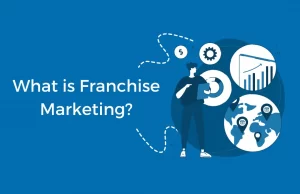
So, franchise marketing can be summarized in this line; the use of marketing strategies, be they conventional or digital, to attract new customers, and new franchisees and to further increase the awareness of its brand among people. This is what franchise marketing is at its core.
Anything that a franchise does in order to further gain new customers or new franchisees, done via marketing, is franchise marketing. These can include advertisements (both in the conventional space and the digital space), search engine optimization (SEO), paid advertisements like PPC, and other tactics like shows, content marketing, email marketing, and others.
Franchise Business Model
The franchise business model concerns itself with an established business, that allows another party to use its intellectual property rights and products for benefit, often called a franchisee, against a fixed amount agreed beforehand as the ‘royalty’ fees. The business model can be understood better with an example, and we’ll look into the Colonel’s business this time.
KFC is a business that’s headquartered in Louisville in Kentucky, and yet you can find one in Arizona or Alaska without its CEO there. How? Well, this is what you call franchising. KFC allows the other parties or franchisees to use its products and sell them in far-off locations. In return, the franchisees pay KFC a royalty for every chicken drumstick that gets sold and pocket the profit for themselves. It is a good business model, one which ensures that both the owners of the business and the franchisees have a share of the profit from the products sold.
In the case of KFC and other food chains, they are spread all across the world, not just countries. This ensures a stream of revenue flowing from the franchisees to the main owners, and it also contributes to local development as well. That’s why it’s such a winner, this business model.
How to do Franchise Marketing?
As stated beforehand, franchise marketing entails in its various marketing schemes and tactics that are usually divided into two categories: conventional and digital. For conventional marketing, you have got your run-of-the-mill adverts in newspapers, local TV, radio, the whole deal. With franchise digital marketing, things get a little interesting. In it, you can find Franchise search engine optimization (SEO), pay-per-click (PPC) advertising, digital marketing, and a whole slew of other related strategies that will help your business have a much better digital footprint and an outreach that can help you get more franchisees and customers alike.
However, the most imperative point here is to have a marketing strategy, with clearly defined goals and targets that said marketing has to achieve. Without a strategy, you will just be winging it, going haphazardly and trying to cover all bases with digital marketing tactics. That would be counterproductive and would only result in a waste of your resources. An ideal franchise marketing strategy would include both conventional and digital marketing, with the end goal being a substantial increase in both new customers and potential franchisees.
How Digital Marketing can help Franchises?

With businesses moving online now more than ever, digital marketing is a realm with more cost-efficiency than any other right now. That is because consumers or customers are now more likely to interact with adverts online, on Facebook, or on YouTube rather than on the TV or in the newspaper. The latter is now just archaic, websites are ruling marketing right now.
So, for starters, digital marketing can help by driving more and more customers towards your business by advertising to them the nearest franchise they can find to their own location. They don’t need to come all the way to the main store when a local Chick-Fil-A has just opened. And this is not just relevant for fast food franchises, nearly every franchise business model can use digital marketing to its advantage, allowing customers to locate their nearest franchise and allowing new franchisees to jump the bandwagon too.
Checklist for Franchise Marketing Success
When we talk about a marketing strategy for your franchise, you can get one right here with the help of this checklist that we’ve enumerated below. What this means is, that following this checklist will go a long way toward your marketing strategy, actually getting you to your goals. We start with the following.
Responsive Website Design
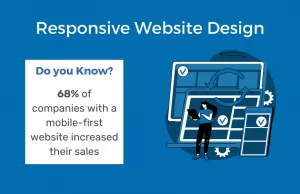
The first and foremost part here to focus on is designing your website. With many of the transactions shifting online to websites, your website needs to do the following: look and operate well, run well and not fail or crash if it experiences a heavy load of users. Design is very important: good design and a consistent design language translate to a good user experience and user interface, which results in repeat customers automatically. Secondly, your website needs to be optimized well; the customer shouldn’t be going through the search engine result pages (SERPs) just to find your website.
Local SEO
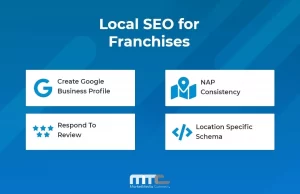
With the franchise business model, local SEO takes preference over general SEO. That is because you are trying to direct a potential customer to the nearest franchise, which is your location, not the other way around. Local SEO will help narrow searches for a particular term or keyword around a particular location, allowing more and more people to be directed towards you when they search for that particular keyword or phrase. There are also many more facets to local SEO for franchise SEO marketing that we will discuss below.
- Google Business Profiles for each Franchise: Google Business Profile will help your business verify itself with the search engine giant for added search engine optimization. This includes a Google Business Profile for each of your franchises, as it will then help Google rank which franchise is official and nearest to the user. They also give you a little tick mark (much like Twitter) to show that you are indeed verified and can be trusted to do business with. This also increases both your ranking and rating and more and more people will then be redirected towards a particular franchise that’s near them. Much like how you might search for ‘Banks near me’ or ‘fast food restaurants near me. The top results that will show up will have good Google Business Profiles all around.
- NAP consistency for SEO: NAP isn’t something to help you sleep (pun intended). NAP stands for Name, Address, Phone number, considered the bedrock for a successful and optimized Google Business profile or page. These are the most viewed details on a Google Business Profile; anybody looking for your business or franchise will use any of these three to locate your premises or contact you. It is also among the first requirements for a Google Business Profile, and as such, is an important part of your SEO and the performance of your franchise marketing strategy.
- Responding to reviews: Another great way to increase engagement with customers (both potential and returning) and help your search engine optimization is by responding to reviews on review aggregator sites (like Yelp!) or on Google Maps, which are a great way of increasing customer outreach and will also help with your SEO. People like to read reviews prior to going for business, and the more the reviews, the better the place. It gets even better if they see that the business itself interacts with the customers, which gives a sense of there being no discord between the business and its customers. Either way, you will be doing your marketing strategy a favor by responding to reviews, both positive and negative.
- Location Specific Schema: Again, with local SEO and a franchise, a location-specific schema will always be useful as it will help with your search engine optimization. Franchisers and franchisees can particularly benefit from that as it is location specific and will allow for searches within a specific geographical boundary to be redirected towards your business or your website.
Social Media Marketing for Franchises
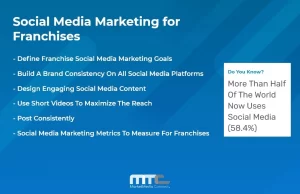
Now that we are done with SEO, let’s move towards what is perhaps the single most important point, the foundation for your franchise digital marketing: social media marketing for franchises.
As you might have known, social media marketing relates to marketing done on social media platforms like Facebook, Twitter, YouTube, or any other platform with a sizeable user base and one which actually provides for marketing or adverts towards its user base. For instance, LinkedIn provides advert services for paying users, as do Facebook and Google. So, in this regard, we will further look into some social media marketing tactics for franchises.
- Defining Goals: We’ve already discussed this beforehand, but a strategy isn’t complete without its objectives, with the goals which are to be achieved with the marketing strategy, and social media marketing is no different. Before we start with the social media marketing strategy, we must begin with defining our goals, which are to be achieved using social media. Is it more customers that your strategy should end with, or is it more franchisees? Goals will help determine your general approach to social media marketing. If you are looking for more customers, your social media strategy will go one way. If you want more franchisees, your social media marketing strategy will go the other way.
- Building Brand Presence, Consistency: Social media isn’t a magic crackpot that gets you leads and conversions from day one. No, you will have to first start from scratch: building a page, building your following, and garnering likes and followers daily. That is our first point: brand presence and consistency. Both are the foundation for your franchise’s digital marketing and your social media marketing strategy in general.
- Engage your Audience with Appealing Content: The most important step in all of this? Your content. Your content needs to be top-notch, and visually appealing and should be able to garner a lot of comments, likes, shares, and whatnot to make sure your outreach through your posts is at its maximum. With this appealing content, you can basically harness the power of social media and get your message across to the customers with ease, using infographics, colors, pictures, videos, you know, the whole deal. This content is your message and medium; you will use this to further catapult your business towards the newer territory, whether it’s to attract new customers or to get new franchisees. Either way, content is king and your king needs to be presented as a king.
- Using Infographics, and Videos for Maximum Outreach: Social media has been hailed as a game-changer because with conventional outreach and marketing methods, your hands were basically tied with either pictures, words, or just a televised advert. With social media, you can combine all three or focus on only one to maximize the impact the content has on the potential customer. Infographics are colorful pictures that convey the maximum number of details in a small, easy-to-consume package, and videos, well, they just rule. Use these two for amplified outreach for your business.
- Using Metrics for Feedback: For feedback, you are not going to go out and ask people to remember if they saw your advert while scrolling Facebook for the eleventh time that day. No, you will use metrics that are automated and give you the best possible feedback from your campaign, including views, clicks, impressions, and a detailed report on how successful your strategy actually was and how many leads and conversions can you expect from it.
Paid Marketing
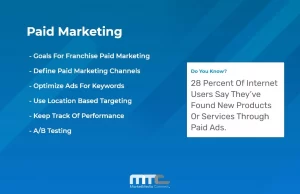
Paid marketing is a tactic by which you pay platforms for all or any leads that might come to your business through them. A prime example of paid marketing would be PPC (pay-per-click) business model, wherein you only pay for the adverts which actually culminate in a lead for your business. This means that you only pay a fraction of what the potential it has, and it’s considered a much better deal than any other form of social media marketing as it is much more cost-efficient.
Let’s look at some more salient points of paid marketing,
- Define Paid Marketing Channels: What channels will you be using for paid marketing? Will it be Facebook or Google’s PPC service? Defining and then selecting your marketing channels is imperative as each one comes with its own set of pros and cons and demography that you can use to your business’s advantage.
- Optimizing Adverts for Keywords: The second point here to take care of is that you need to optimize your adverts for keywords, which in turn will ensure that more and more traffic is diverted towards your website whenever a particular keyword is searched for.
- Using Location Based Targeting: Using location-based targeting is imperative, especially in the context of a franchise, as they depend much on local transactions or customers for their business. With location-based targeting, again, you can capitalize on people searching for your business within a certain locality, and these are much more likely to materialize in the form of a lead or business.
- Tracking the Performance of the Strategy: The next step would be to track the performance of your social media marketing strategy, and how you can quantify and gauge it against a set benchmark that corresponds closely with the goals that you have set for your strategy. With these markers in mind, you can track the performance of your social media marketing strategy.
- A/B Testing: A/B testing is when you test out two different models or strategies side-by-side to gauge which one is the more efficient one. With social media marketing strategies, it basically means that you can run two strategies simultaneously to know which one performs better and which one needs to be replaced.
Email Marketing for Franchises
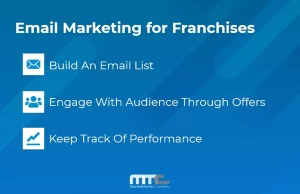
Email marketing might seem like a concept from the past, but no, that isn’t the case. It is still relevant, and more and more businesses, especially the ones following the franchise model, are using it for their business goals. Here are some of the salient features here.
Building an Email list
Who will you actually email your business particulars to? This is the main concern of an email list, which is essentially a list of people and their emails most likely to respond to your emails as they either work in the same industry or are connected to whatever product or service you are selling. So, building an email list, whether it is for new customers or new franchisees, is going to be the first step.
Engaging Audiences
Emails might be boring and redundant, but if an email tells you of a discount at your local Taco Bell, well, not so boring now, is it? Use emails to communicate to your customers about exciting new deals, promotions, or discounts, and you can watch as the business pours in.
Keeping Track of Performance
Email marketing has specific software that can be used, which also provides feedback metrics and other tools for you to gauge how successful a particular email campaign has been. Use it for your feedback.
Some Commonly asked Questions
Here are the answers to some commonly asked questions that are persistent in this line of business.










